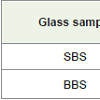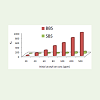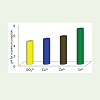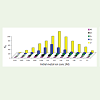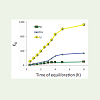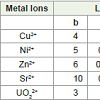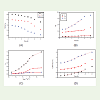Research Article
Barium Borosilicate Glasses: RoomTemperature Sorbents For Radioactive and Transition Metal Ions
Jayshree Ramkumar* and Chandramouleeswaran S
Analytical Chemistry Division, Bhabha Atomic Research Centre, Mumbai-400085, India
Corresponding author: Jayshree Ramkumar, Analytical Chemistry Division, Bhabha Atomic Research Centre,Mumbai-400085, India, E-mail: jrk@barc.gov.in
Citation:Ramkumar J, Chandramouleeswaran S. Barium Borosilicate Glasses: Room Temperature Sorbents For Radioactive and Transition Metal Ions. J Chem Applied Biochem. 2017;4(1): 121.
Copyright © 2017 Ramkumar J, et al. This is an open access article distributed under the Creative Commons Attribution License, which permits unrestricted use, distribution, and reproduction in any medium, provided the original work is properly cited.
Submission: 20/04/2017; Accepted: 30/04/2017; Published: 10/05/2017
Abstract
The sorption behavior of borosilicate glasses with respect to radioactive metal ions like uranyl, strontium and transition metal ions like Cu2+, Ni2+ and Zn2+ have been studied in detail. Various parameters including pH, initial concentration of metal ion, time of equilibration, are varied. The sorption behavior is then compared to that of Sodium Borosilicate (SBS) glasses. Under optimized experimental conditions, the sorption follows the pseudo second order model for uranyl and copper ions while sorption of strontium follows pseudo first order. The fit with Weber-Morris and Boyd models show that the overall sorption is controlled by both external mass transfer and intraparticle diffusion.
Keywords: Borosilicate glasses; Sorption; Uranyl; Strontium; Copper; pH sensitive; External mass transfer; Intraparticle diffusion
Introduction
Separation of metal ions from aqueous solutions is very important from environmental point of view. Since the advent of nuclear power, the search has been ongoing for suitable treatment protocols of radioactive wastes. Unlike the waste encountered in other industries, radioactive waste assumes special importance and different dimensions owing to the associated radiation hazard. Many alternatives for their treatment have been investigated and some of them have been applied successfully in the waste treatment plants. However, no method is universally applicable and the adoption of any treatment technique for a given type of waste will depend on the efficacy of the method, the characteristics of the waste, the availability of the material and of course economical considerations. It is important to remove these ions for the safe disposal of high liquid wastes. Removal of these ions will convert the high active waste into middle or low active waste which can be disposed underground after solidification. Moreover, the recovery of some metal ions may also be of economical interests.
Amongst all the available procedures, sorption appears asa favorable alternate because of its efficacy, practicality, andeconomical feasibility, depending on the sorbents used [1,2]. The processes of metal retention by solid phases are controlled by different mechanisms: adsorption to surface-active sites (ionic exchange, specific adsorption). Studies using borosilicate glasses as room temperature sorbents have been reported in our lab earlier and the composition of glass was an important parameter that affected the sorption capacity [3-6]. Batch equilibrium studies are normally employed to understand the sorption behavior. The sorption data were fitted to isotherms which are analyzed to provide information about the retention capacity and the strength by which the ions are held on to the glass. The adsorption models deal with the equilibrium of the metal ions between the aqueous solution and the solid phase.
In the present study, sorption of radioactive metal ions likeuranyl, Sr2+ and transition metal ions like Cu2+, Ni2+ and Zn2+ have been studied using barium borosilicate glass and compared its uptake capacity with respect to sodium borosilicate glass. Extensive modeling was carried out to get an insight to the sorption process.
Experimental
Solution of metal ions were prepared using the appropriate salts and dissolving them in dilute acid and making up to the mark using distilled water. The uranyl and strontium solutions were prepared by weighing appropriate amounts of the salt (Uranyl acetate and strontium nitrate A.R. E. Merck respectively), dissolved in a small amount of nitric acid and made up to the volume using distilled water. Transition metal ion solutions were prepared by dissolving the appropriate amounts of the chloride salts (S.D. Fine Chemicals Ltd., India) in dilute acid and made up to the volume using distilled water and standardized by standard protocols. A buffer of sodium acetate and acetic acid is prepared to get a pH of around 4. The pH measurements are carried out using an EIL 7030 pH meter equipped with a combination electrode. The analysis of metal ions was carried out using a sequential inductively coupled atomic emission plasma spectrometer from HORIBA Jobin Yvon (ISA Jobin Yvon - JY 2000 - Sequential ICP-OES Spectrometer). The synthesized glass samples (using protocol reported) were used for sorption experiments at room temperature in batch mode using a simple procedure. A known weight of glass sample is equilibrated with 10 ml of metal ion solution at a particular pH for a known period. The solution is then centrifuged and the filtrate is analyzed for the metal ion by ICPAES.
Results and Discussions
The molar compositions of the two glass samples SBS and BBS are given in Table 1. The detailed structural elucidation reported earlier revealed the amorphous nature of borosilicate network due to the glassy structure [7]. 29Si and 11B Magic Angle Spinning NMR patterns revealed the presence of borate and silicate anionic groups which could contribute to the ion exchange property of borosilicate glasses [7]. It is worth mentioning that the in the NMR patterns of both barium borosilicate and sodium borosilicate, the line shape and peak position are identical thus indicating that only minor amount of BaO added acts as a network modifier.
Sorption studies
In order to optimize the different experimental parameters that affect sorption capacity, the studies were carried out in batch mode by equilibration for 5 h at different experimental conditions. The sorption efficiency is correlated to the distribution coefficient (ratio of amount sorbed (mg/g) to amount in solution (mg/mL) with units of mL/g. Different experimental parameters were optimized to get maximum uptake. The effect of glass composition was studied using barium borosilicate glass and comparing its sorption behavior with that of sodium borosilicate glass. The composition of the two glass samples is given in Table 1.
Initial studies were carried out with both BBS and SBS and tested for sorption of uranyl ion at different concentrations and the results are given in Figure 1. From the compositions of BBS and SBS, it is seen that the SiO2 to Na2O is same for both the glasses. The network modifiers result in the conversion of Si-O-Si to Si-O- Na+ or Si- O-H linkages thereby increasing the concentration of non bridging oxygen atoms in the glass which results in the increased ion exchange capacity of BBS as compared to SBS. Further studies were carried out with BBS only.
The uptake of metal ions proceeds via an ion exchange mechanism and therefore pH of the external solution is an important parameter that needs to be optimized.
Figure 2 shows the pH for different metal ions at which maximum sorption occurs. It is seen that sorption is maximum for uranyl, copper, zinc and strontium ions at pH values of 4.5, 5, 5.5 and 7 respectively. Thus it can be seen that the pH provides a means of separating these ions if present in a mixture. The trend in pH variation studies arise from the fact that at higher pH uranyl and transition metal ions have a tendency to get hydrolyzed and therefore their uptake reduces at higher pH. However for strontium, the tendency to hydrolyze is reduced and so shows higher uptake with increase in pH. However, with further increase in pH, the uptake of strontium reduces due to competition with the Na+ ions present in solution. Thus the optimized pH was used for individual metal ion studies.
The effect of initial concentration of metal ion on distribution coefficient was carried out in the concentration range of 0 to 0.08M for all the metal ions. The results are given in Figure 3.
It is seen that for all the metal ions, KD increases up to a particular initial metal ion concentration and then decreases. This can be explained as follows. Sorption is an equilibrium process which is influenced by the initial metal ion concentration. At lower metal ion concentration, the sorption sites are available and therefore the value of KD increases. Beyond a particular concentration, the decrease could be attributed to the fact that sorption has reached saturation and further increase in metal ion concentration reduces the ratio (KD) as the amount remaining in solution keeps increasing. It is interesting to note that the concentration at which the maximum KD is obtained is different for each metal ion (Figure 3). The maxima of distribution coefficient values are found at concentrations of 0.006, 0.008, 0.01, 0.02 and 0.06 M for Ni2+, Zn2+, Cu2+, UO22+ and Sr2+ respectively. These results are again very interesting and encouraging as it leads to a possible separation between different metal ions. It is clear that UO22+ will not have much interference from Ni2+, Zn2+ but interferences from Cu2+ will be encountered. Thus it is seen that pH and initial metal ion concentrations can also lead to some degree of selectivity in the separation.
Since time of equilibration was already kept at 5 h for optimization of other experimental parameters, it was proposed to carry out the time variation to enable us to understand the changes with time and also get an insight to the sorption process. Therefore, under optimized experimental conditions of pH, initial metal ion concentration etc the time of equilibration was varied between 0-8 h. The results are shown in Figure 4. It is seen that maximum sorption was nearly complete within 5 h and further increase time of equilibration resulted in only 12% increase in the sorption values. Hence the initial studies carried out using 5 h of equilibration can be safely considered to be nearly complete. Moreover, it needs to be mentioned that in sorption, very long equilibration periods are also not very attractive and therefore unless the sorption is phenomenally increased in 8 h, the studies can be carried out for a period of 5 h.
Treatment of Sorption Data
The sorption data are fitted to commonly used equilibrium and kinetic models to get an understanding of the sorption process [8-11]. The most commonly used equilibrium models are the Langmuir and Freundlich represented by their linear forms in Eqs 1 and 2 respectively, wherein qe is the amount adsorbed at equilibrium (mg/g), Ce is the equilibrium concentration (mg/L), Q0 (practical limiting sorption capacity when surface is completely covered), b, Kf and n are constants indicative of energy of sorption (L/mg), sorption capacity and sorption intensity respectively. The Langmuir model represents a monolayer sorption while a Freundlich model corresponds to multilayer sorption.


The results of this analysis are given in Table 2. From Langmuir modeling, the Langmuir constant b (related to energy of sorption) is used for calculation of RL which gives an indication as to whether the sorption is favorable or not. In the present studies, the sorption is favorable but not all metal ions show monolayer sorption as can be seen from the R2 value in the table. It is seen that Freundlich model is applicable to uranyl, copper and to certain extent zinc ions indicating that sorption is not monolayer. The value of 1/n between 0 - 10 indicates favorable sorption as seen in the present case. However if the value of 1/n is below one it indicates a normal sorption while a value greater than 1 indicates cooperative sorption as is seen in the case of uranyl, copper and zinc ions. This could be due to some kind of structures formed between the ions with each other or even with sorption sites thereby negating the possibility of a monolayer sorption. This is again corroborated by the observation that for these ions, the Langmuir model does not fit well.
The sorption data with respect to time was fitted to both pseudo first and second order kinetic models given by Eq 3 and 4 respectively.


When a powdered solid sorbent material is in contact with a solution containing metal ions, the ions have to migrate from bulk to the surface of the liquid film. The surface exerts a diffusion barrier which can either be very or least significant. The significance of this barrier can be understood by the dominant role of the film diffusion in sorption. Also the rate of sorption can be controlled by external diffusion, internal diffusion or both. The external diffusion controls the migration of the solute species from the solution to the boundary layer of the liquid phase. However, the internal diffusion controls the transfer of the solute species from the external surface of the sorbent to the internal surface of the pores and further any of the three following steps viz transport of the (i) ingoing sorbate ions to external surface of the adsorbent (film diffusion), (ii) sorbate ions within the pores of the adsorbent and a small amount of sorption on the external surface (particle diffusion) and (iii) sorption of the ingoing sorbate ions on the interior surface of the adsorbent. Out of these three processes, the third process is very fast and is not the rate limiting step while the first two steps can result in three cases wherein rate can be governed by particle diffusion (External transport > internal transport), film diffusion (External transport < internal transport) and transport of sorbate ions to boundary (External transport ≈ internal transport) leading to formation of concentration gradients in the film. The sorption mechanism may proceed in several steps and the slowest step is the rate determining step. In general, pore and intraparticle diffusion are often rate-limiting. The correlation of diffusion and rate determination step cannot be evaluated using the pseudo first and second order models. Thus Weber-Morris model given by Eq.5 (where q (mg/g) is the amount adsorbed at time t, and KID the rate constant (mg/gh0.5)) is used to describe the time evolution of the concentration in adsorbed state. According to the model, the plot of qt vs t0.5 should give a straight line when diffusion plays a role in the sorption rate and should cross the origin if intraparticle diffusion is the rate determining step. Another model developed by Boyd is also used for understanding the intraparticle diffusion for spherical particles. It is much better understood as the film diffusion model and is given in its linearized form by Eq.6 wherein a linear dependence through origin between the fraction tending to equilibrium F (F= qt/ qe) and time is obtained and the external mass transfer coefficient can be calculated. Particle diffusion is often the rate controlling step and pore diffusion coefficients for intraparticle transport can be calculated from Eq.7.


The results of kinetic studies are given in Figure 5 and the various parameters calculated from these studies are given in Table 3 . It is seen that the different models give different information about the sorption process. From the results it is seen that sorption of strontium follows both pseudo first and second order models while copper and uranyl ion sorption show better fit with pseudo second order model as seen by the R2 values. This can be understood as follows. The sorption of Sr is chemisorption in nature but since it also fits well with pseudo first order model, it indicates the absence of any sorbate interactions (Figures 5A and 5B). This corroborates with the discussion of equilibrium modeling. For copper and uranyl ions, chemisorptions occur and a probable interaction between the ions is possible. The ion exchange process maybe the only mode of sorption in case of strontium. However for the other two ions, ion exchange process may also occur in addition to various other factors leading to sorption.
The fitting of Weber-Morris intraparticle diffusion model for thethree ions gives interesting results. It is seen from Figure 5C that for uranyl and copper ions, there are three different linear portions while strontium has only two. Regression analysis of the different regions for the ions has been carried out in detail and the slope of the each linear region gives the value of intraparticle diffusion rate constant KID with units of mg/g*h0.5 are given in Table 3. As the plots do not cross the origin it is possible that both intraparticle diffusion and external mass transfer occur simultaneously. For uranyl ion it is seen that the first linear portion in the time range of 0.5-1.5 h represents the external mass transfer with a slope value of 0.4754. The second linear portion which extends from 1.7-2.3 h has a value of 1.0315 and represents intraparticle diffusion while the third linear portion from 2.3-3 h represents the sorption-desorption equilibrium with a slope value of 0.4012. Thus the rate limiting of uranyl sorption is the intraparticle diffusion. For copper sorption, the three linear portions have similar time ranges as that of uranyl ion with the slopes of the regions being 0.1070, 0.4959 and 0.0883 respectively. For copper sorption the intraparticle diffusion is the predominant step that affects the rate. For strontium sorption, it is seen that the two linear regions are in the time range of 0.7-2.3 and 2.3-3 h respectively. Thus it is seen that for strontium sorption only external mass transfer plays a very prominent role and the values of the slopes are 0.0384 and 0.0219 respectively. The intraparticle diffusion is found to affect the sorption of uranyl and copper ions while external mass transfer is the only dominant process for strontium sorption. This again is in correlation with the fact that for strontium, the sorption is monolayer and therefore there are no other processes existing.
In order to further understand whether the intraparticle diffusion is film diffusion or pore diffusion, the particles are assumed to be spherical and diffusion coefficient is calculated using Eq 7 or 8 depending on whether his film or pore diffusion respectively. In these two equations, ro is radius of the sorbent (cm), DP and DF are the pore and film diffusion coefficients respectively (cm2/sec), ∂ is the film thickness (cm) and t0.5 is the time for half change (sec).


It is reported in literature that for film and particle diffusion to be involved in the rate determining step, the values of diffusion coefficients DF and DP should be in the range 10-6-10-8 and 10-11- 10-13 cm2/s respectively. In order to find out the nature of the process responsible for sorption on to chosen sorbent, attempts were made to calculate the diffusion coefficient of the process using Eqs 7 and 8. In the present studies the values of diffusion coefficient for the uranyl and copper ions are in the order of 10-9 cm2/s which indicate that both particle and film diffusion contribute to the rate limiting step in the sorption. Boyd’s model has also been utilized to understand the sorption process (Eq.6). The value of B calculated from the slope of Boyd’s plot has been used to calculate the diffusion coefficient Di using the Eq 9, wherein ro is the radius of the sorbent particle.

The value of diffusion coefficient calculated (Table 3) are of the order of 10-9 cm2/s indicating the important role of both film and intraparticle diffusion in sorption for uranyl and copper ion sorption.
Conclusion
The present study shows that use of barium borosilicate glass as an effective room temperature sorbent for the sorption of different radioactive and transition metal ions. The present study shows uptake capacity is quite reasonable but the main attraction is that the sorbent is really cheap and easily available. The possibility of using glasses as sorbents seems interesting as it gives path to the possible use of unwanted glass or the waste generated from use of glass products. The main aim of the present work was to demonstrate the sorption capability of the glass samples and to understand the sorption using equilibrium and kinetic modeling using different models. The extensive modeling indicates that the sorption follows an ion exchange mechanism for strontium uptake but for both uranium and copper ions, a simple ion exchange does not occur. It is also seen that diffusion and external mass transfer control the overall sorption process for uranyl and copper ions but for strontium, only external mass transfer exists.
Acknowledgment
The authors thank Dr. Naik PD, CG and BARC for the support and also Dr. Mishra RK, BARC for the glass samples.
References
- Chandramouleeswaran S, Ramkumar J (2014) n-Benzoyl-n-phenyl hydroxylamine impregnated Amberlite XAD-4 beads for selective removal of thorium. J Hazard Mater 280: 514-523.
- Ramkumar J, Chandramouleeswaran S (2013) Separation of uranyl ion using polyaniline. J Radioanal Nuc Chem 298: 1543-1549.
- Ramkumar J, Chandramouleeswaran S, Sudarsan V, Vatsa RK, Shobha S, et al. (2010) Boroaluminosilicate glasses as ion exchange materials. J Non-Crys Solids 356: 2813-2819.
- Ramkumar J, Chandramouleeswaran S, Sudarsan V, Mishra RK, Kaushik CP, et al. (2009) Barium borosilicate glass as a matrix for the uptake of dyes. J Hazard Mater 172: 457-464.
- Chandramouleeswaran S, Ramkumar J, Sudarsan V, Reddy AV (2011) Boroaluminosilicate glasses: novel sorbents for separation of Th and U. J Hazard Mater 198: 159-164.
- Ramkumar J, Chandramouleeswaran S, Sudarsan V, Mishra RK, Kaushik CP, et al. (2009) Barium borosilicate glass as a matrix for the uptake of dyes. J Hazard Mater 172: 457-464.
- Ramkumar J, Sudarsan V, Chandramouleeswaran S, Shrikhande VK, Kothiyal GP, et al. (2008) Structural studies on boroaluminosilicate glasses. J Non-Crys Solids 354: 1591-1597.
- Majeed J, Ramkumar J, Chandramouleeswaran S, Jayakumar OD, Tyagi AK (2013) Kinetic modeling: dependence of structural and sorption properties of ZnO-crucial role of synthesis. RSC Adv 3: 3365-3373.
- Majeed J, Ramkumar J, Chandramouleeswaran S, Tyagi AK (2014) Highly selective uptake of copper (II) ions from aqueous media using nanosorbents in batch mode. Adv Por Mater 2: 69-78.
- Dutta DP, Mathur A, Ramkumar J, Tyagi AK (2014) RSC Adv 4: 37027-37035.
- Singh A, Dutta DP, Ramkumar J, Bhattacharya K, Tyagi AK, et al. (2013) RSC Adv 3: 22580-22590.

